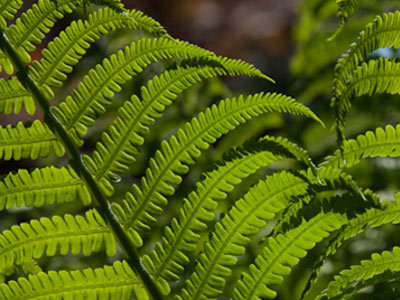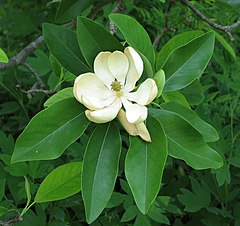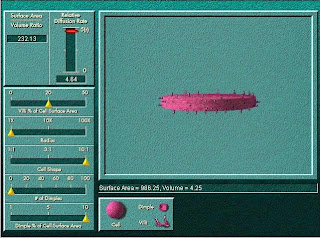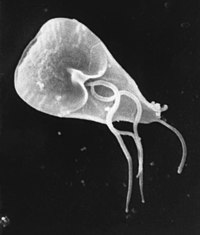Charophyceans
Charophyceans are the green algae that are most closely related to plants. They have cell walls that are made of cellulose and have the presence of chlorophylls a and b within the chloroplasts. Charophyceans are equipped with rose-shaped arrays of proteins that synthesize the cellulose microfibrils of the cell walls. They also have peroxisomes that make them closely related to land plants. They have flagellated sperm cells and are involved in the cell division formation of phragmoplast.
Bryophytes
Bryophytes have three separate phyla: liverworts, hornworts, and mosses. Mosses are the most familiar in bryophytes. It is a nonvascular plant with gametophyte being the dominate generation in their life cycles. The lack conducting tissues that help them distribute water and organic compounds within their thick tissues. Because they do not have lignified vascular tissues, their growth height is limited. These plants are common in moist alpine, boreal temperate, tropical forests and wetlands.
Pteridophytes
Pteridophytes are seedless vascular plants and have roots with lignified vascular tissue. Because their vascular system resembles earlier vascular plants, this suggests that their roots evolved from the subterranean portions of stems of ancient vascular plants. There are two phyla involved: Lycophyta and Pterophyta (ferns, whisk ferns, horsetails). For reproduction, sporophyte dominates its life cycle. Megaspores develop into female gametophytes bearing archegonia while microspores develop into male gametophytes with antheridia. Water ferns are the only heterosporous species. Because of their swimming sperm and fragile gametophytes, pteridophytes are most common in relatively damp habitats.
Gymnosperms
Gymnosperms lack enclosed chambers, also known as ovaries, where angiosperm ovules and seeds develop. Another name for gymnosperms is the naked seed. These seed bearing plants include conifers, pines, ginkos, and cycads. Most conifers are evergreens, retaining their leaves throughout the year. They are adapted to dry conditions and are amongst the largest and oldest organisms on Earth. Conifers are heterosporous. Both male and female gametophytes develop from different types of spores by separate cones. If a seed lands in a habitable place and beings to germinate, then the embryo emerges as a pine seedling.
Angiosperms
Angiosperms are also known as flowering plants. Angiosperms are vascular plants with seeds. They are divided into two main classes which differ in anatomical and morphological details: the monocots and the dicots. The flower in the angiosperm structure is specialized for reproduction and includes four circles of modified leaves: sepals, petals, stamens, and carpels. After reproduction, the fruit is a mature ovary which the seeds of the angiosperm are dispersed by wind or animals. They are involved in coevolution where the pollinator-plant relationship is cause of the diversity of flowers. They play an important role in terrestrial ecosystems because animals pollinate the flowers while animals other animals transport the seeds to new and different locations. Angiosperms play an important role in agriculture because if provides nearly all our food. All our fruit and vegetable crops are angiosperms.
Source: Campbell book
Saturday, January 21, 2012
Extreme Organism
One extremophile is the tardigrades, also known as waterbears or moss piglets. It is part of the superphylum Ecdysozoa. They have eight legs and are microscopic. Tardigrades can be found in lichens and mosses, dunes, beaches, soil, marine or freshwater sediments, or a soaking piece of moss in spring water. Tardigrades are considered an extreme organism because they are available to survive in environments that would kill other organisms. They feed on the fluids of plants and animal cells. For a tardigrade’s life span, if it never go into a dormant state, then they only live for less than a year, whereas if they do go into dormant state, they can live up to 60 years. As for reproduction, they are oviparous and fertilization is usually external. The eggs hatch no later than fourteen days and the organism hatched already possess its adult cells. They can survive in temperatures near −273 °C (−459 °F) and 151 °C (304 °F). This temperature range has 1,000 times more radiation than other animals would absorb. They can also survive in very low and very high pressure and survive in nearly ten years of dehydration.
Source: http://www.iwu.edu/~tardisdp/tardigrade_facts.html
Source: http://www.iwu.edu/~tardisdp/tardigrade_facts.html
Cell Poem
Dear cell,
all eukaryotic cell
all prokaryotic cell
you all make me so well because you do not smell.
The nucleus,
you hold the DNA and the genes,
making me want to take a tour of your cell on a bus.
Ribosomes
producing proteins is what they do
you make me want to go to the zoo.
Golgi apparatus, cis and trans,
feels like sorting shoes from boots to laces to vans.
Endoplasmic reticulum, so smooth and rough
are you considered tough and buff?
Dear cell membrane,
includes the integral proteins which penetrates the lipid bilayer
and the peripheral proteins which are not embedded in the lipid bilayer.
please be permeable and let substances pass through you without a hassle,
needing transport protein, carrier proteins, channel proteins.
Protecting the cell is your role.
Dear cell signaling,
signal transduction pathway is a multistep process for cellular response
local regular and hormones brings organisms together
ligands bind from small molecules to big molecules.
reception, transduction, and response are the stages to cell signaling.
Cell signaling is vital to the cell’s communication process.
all eukaryotic cell
all prokaryotic cell
you all make me so well because you do not smell.
The nucleus,
you hold the DNA and the genes,
making me want to take a tour of your cell on a bus.
Ribosomes
producing proteins is what they do
you make me want to go to the zoo.
Golgi apparatus, cis and trans,
feels like sorting shoes from boots to laces to vans.
Endoplasmic reticulum, so smooth and rough
are you considered tough and buff?
Dear cell membrane,
includes the integral proteins which penetrates the lipid bilayer
and the peripheral proteins which are not embedded in the lipid bilayer.
please be permeable and let substances pass through you without a hassle,
needing transport protein, carrier proteins, channel proteins.
Protecting the cell is your role.
Dear cell signaling,
signal transduction pathway is a multistep process for cellular response
local regular and hormones brings organisms together
ligands bind from small molecules to big molecules.
reception, transduction, and response are the stages to cell signaling.
Cell signaling is vital to the cell’s communication process.
Three Key Ideas for Time, Love, Memory
In Quinn’s experiment, he put mutant flies into a countercurrent machine with two smells: octanol which is relatively bad, and methylcyclohexanol which is relatively good. When the flies went toward the light with octanol, Quinn gave them a chock. When the flies went toward the light with methylcyclohexanol, he did not give them a shock. After a couple of repeated experiments in a new test tube, Quinn concluded that the flies were learning from their own experience. This is similar to what we have learned in the animal behavior chapters. This experiment is related to a taxis or kinesis movement where organisms learn from repeated mistakes or experiments. The flies have learned after countless of experiments to move away from the light in an octanol environment and move toward the methlcyclohexanol environment.
As mentioned in the book, Time, Love, Memory, flies tend to form chains with each other. On pg. 126, it states that if there is good food and a nice warm constant temperature, it encourages the flies to start chaining. Food is rather important to these flies. This relates to what we are learning because all organisms require an adequate amount of food, a good temperature range, and a good social environment that helps flies become more active and therefore, allowing them to reproduce.
Throughout this book, clocks have been mentioned several times about having specific timings which they function. Clocks control the rhythmic behavior of life. This relates to photosynthesis. Just like how in photosynthesis, C3, C4 and CAM plants, some of these plants function at nighttime whereas some work during the daylight. CAM plants open their stomata at night and close them during the day, the reverse way of when other plants open their stomata during daylight. It is also similar as to when we humans have clocks in our bodies, requiring us to wake up, eat our three daily meals, and sleep around the same specific times.
As mentioned in the book, Time, Love, Memory, flies tend to form chains with each other. On pg. 126, it states that if there is good food and a nice warm constant temperature, it encourages the flies to start chaining. Food is rather important to these flies. This relates to what we are learning because all organisms require an adequate amount of food, a good temperature range, and a good social environment that helps flies become more active and therefore, allowing them to reproduce.
Throughout this book, clocks have been mentioned several times about having specific timings which they function. Clocks control the rhythmic behavior of life. This relates to photosynthesis. Just like how in photosynthesis, C3, C4 and CAM plants, some of these plants function at nighttime whereas some work during the daylight. CAM plants open their stomata at night and close them during the day, the reverse way of when other plants open their stomata during daylight. It is also similar as to when we humans have clocks in our bodies, requiring us to wake up, eat our three daily meals, and sleep around the same specific times.
Article: On Societies as Organisms
In this article, the author mainly talks about how although organisms are separate individuals, but when combined, they become one big entire organism. One big example is the ant. If they are wandering individually, they are small creatures. When they are all crowding around one similar area, then you can begin to see “the whole beast”. Termites and bees are also described similarly to the ants. Bees distribute themselves equally to work efficiently for the queen. “The phenomenon of separate animals joining up to form an organism is not unique to insects.” This means that most organisms have worked together to accomplish tasks before, and joining up is considered normal. As for humans, although we are one human being, we are all linked together for information. I agree with this article because each and every one of us are all separate humans and organisms, but at some point, we always work together during our lifetime.
Article: Thoughts for a Countdown
This article talks about how humans from another plant will view other organisms from another plant as something that shouldn’t be reconciled with. In the beginning of this article, when astronauts arrive at the moon, they wear surgical masks, meaning that they do not want to touch anything with their bare hands because they do not know what life is on the moon. If there is really life on the moon, then we “must begin by fearing it. We must guard against it.” We live with other living things in harmony. Other than organisms, we humans also exhibit symbiotic relationships. “Every creature is connected to and dependent on the rest.” It means that we all need each other. Microbes and bacteria have been said to collaborate, accommodate, exchange, and barter with each other. For example, all organisms have their own way for survival and what they do for a living. Anemones can recognize molecular configurations while crabs can recognize their own anemone. In the end of the article, Theodor says, “if same species are placed in close contact, the smaller of the two will always begin to disintegrate.” Theodor is saying that those two organisms have the same niche they need in order to survive. They will compete for it, perhaps overpowering the other party, causing the other party to start being extinct and disintegrate. I agree with this article because people will also fight for what they want because they will be able to live and survive better with it. Humans are also putting on gloves and wearing masks as they walk outdoors because they do not want to be contaminated with others’ germs.
Article: The Lives of a Cell
This article mainly focuses on how each individual and organism on this plant is interlocked with each other. In the beginning, the article states that the man is similar to “a lethal force whereas the earth is pictured as something delicate”, overall resulting to the idea that man is embedded within nature. The article says that “we are shared, rented, occupied”. There are organelles in our bodies that are driving our every day movements, and these organelles are not strictly ours. For example, the mitochondria, centrioles, basal bodies, and other organelles work inside our bodies, each with its own special genome. We should believe that these organelles are functioning for our own benefits, but it may be that the organelles are the reason why we are doing movements that we are doing now. It is similar to an example in the article, where green plants cannot be plants or be green without their chloroplast for photosynthesis; these chloroplasts are separate creatures within their own genomes. Overall, the man feels that there is differentiation and speciation, but does not feel separate at all. I agree with his man’s feelings because I believe that all the organelles inside our bodies function as one unit, each relating and leading to one another. We are connected to our inner bodies and how they function and what their outcome is depends on us and the interior of our cells.
Wednesday, January 11, 2012
Lit. Circle Book: Time, Love, Memory
In Time, Love, Memory, what surprised me the most was the experiment on how mutant fruit flies tend to move toward the light rather than the dark. Ever since Chapter 1, the experiment created by Seymour Benzer has reappeared in almost every chapter. In Benzer’s experiment, he connected two test tubes and put them mouth to mouth. He put one end of the test tube under the light while the other end of the test tube was in the darkness. He would make sure that the test tubes were still and tap the glass in order for the flies to start their movements. After countless of experiments, Benzer concluded that most of the flies moved toward the light. From my observations, the flies in my room like to fly in both dark and light environments. Although fruit flies are different from normal flies, I never thought about how the flies move. Benzer’s experiment was one of the most interesting and surprising experiments to me because I never thought about observing what the flies’ movements were like.
Source: Time, Love, Memory by Jonathan Weiner
Source: Time, Love, Memory by Jonathan Weiner
Tuesday, January 10, 2012
Article: A Fear of Pheromones
In the article, “A Fear of Pheromones,” animals are not the only organisms that can release odors; humans can as well. Some chemical odors can either confuse or attract other organisms to each other. After reading through the ecology chapters, chemical odors are sometimes used to tell other organisms around the same vicinity a warning that predators are near and to find safety quickly. According to this article, pheromones are small, simple molecules that are active in extremely small concentrations. A neighboring territory could possibly smell the scent of the odor and react to it quickly. The odors can also have a “fragrance of ambiguity”. An example is the female moth; if it releases bombykol, that single molecule can tremble the hairs of any males relatively far within miles, causing that male to become confused. Another example is when the female monkeys respond to the estradiol released by the male primates. Other than causing the organisms to become confused, pheromones can help organisms identify what type of species the organisms is. An example is that fishes make use of chemical signals for identifying individual members of a species and announcing the changes in the statuses of certain individuals. Although there is not much information about humans being involved with pheromones until recently, I agree with this article because it states important key facts. I believe that humans can communicate and react with each other based on their pheromones. Just like the example given in the article where the dog is able to sniff out their owner shows that we humans release a scent which allows the animals to recognize their owner. In our world, there are females who sprays an excessive amount of perfume on and males who sprays axe on themselves. The scent disperses and individuals near the person may tend to walk away because the scent is so strong that it is unbearable, or walk towards it because the scent is fragrant.
Friday, January 6, 2012
Virtual Diffusion Lab
In order for the cell to have the highest rate of diffusion, the cell must have:
Surface area: 986.25
Volume: 4.25
Surface area/volume ratio: 232.13
Villi: 20%
Radius: 1X
Cell shape: 10:1
Number of dimples: 0
Dimple % of cell surface area: 10
Source: http://www.mhhe.com/biosci/genbio/biolink/j_explorations/ch02expl.htm
Wednesday, January 4, 2012
Exemplars of Each Phyla of Protozoa
Diplomonadida
Giardia lamblia is an anaerobic parasite that colonizes and reproduces in the small intestine. It causes abdominal cramps and severe diarrhea. People pick up Giardia by drinking water that is contaminated with human feces.
Parabasala
Trichomonas vaginalis inhabits a female's vagina. It has both flagella and an undulating membrane. These structures allow the protist to move within the reproductive and urinary tracts of it's host.
Euglenozoa
Kinetoplastids has a large mitochondria with an organelle called the kinetoplast. The kinetoplast holds extranuclear DNA. The kinetoplastid are symbiotic and pathogenic to their hosts.
Alveolata
Dinoflagellates are abundant in aquatic pastures of phytoplankton near the water surface. Most are unicellar, having a shape reinforced by internal plates of cellulose. When they bloom, they cause red tides in coastal waters. Toxins produced have killed fish and invertebrates, which can also be deadly to humans as well.
Apicomplexans are parasites of animals. These parasites can disseminate as tiny infectious cells called sporozoites. The sporozoites contain specialized organelles for penetrating host cells and tissues. They have a complex life cycle, usually involving two or more host cells.
Stramenopila
Diatoms have unique glasslike walls, with each wall overlapping each other. They reproduce asexually by mitotic cell divisions. Both freshwater and marine plankton are rich in diatoms. These diatoms store food reserves in the form of a glucose polymer called the laminarin.
Golden algae are biflagellated with both flagella attached near the end of the cell. They are mixotrophic and unicellular.
Rhodophyta
Red algae lack flagella and are adapted to different water depths. The red algae is the most abundant large algae in the warm coastal waters of tropical oceans. They are multicellular, and also similar to the seaweed brown algae.
Chlorophyta
Green algae are named for their chloroplasts. Their common ancestors might have chloroplasts from cyanobacteria. They are closely related to land plants. Most chlorophytes live in plankton or inhabit damp soil or snow while some live symbiotically with other eukaryotes. They also live symbiotically with lichens.
Mycetozoa
Plasmodial slime molds are brightly yellow or orange pigment. They are heterotrophic with a feeding stage called the plasmodium which contains many nuclei. The plasmodium engulfs food particles by phagocytosis.
Cellular slime mold contains cells that maintain their identity and remain separated by their membranes. They are haploid organisms which have fruiting bodies that function in asexual reproduction. They have no flagellated stage.
Source: Campbell book
Giardia lamblia is an anaerobic parasite that colonizes and reproduces in the small intestine. It causes abdominal cramps and severe diarrhea. People pick up Giardia by drinking water that is contaminated with human feces.
Parabasala
Trichomonas vaginalis inhabits a female's vagina. It has both flagella and an undulating membrane. These structures allow the protist to move within the reproductive and urinary tracts of it's host.
Euglenozoa
Kinetoplastids has a large mitochondria with an organelle called the kinetoplast. The kinetoplast holds extranuclear DNA. The kinetoplastid are symbiotic and pathogenic to their hosts.
Alveolata
Dinoflagellates are abundant in aquatic pastures of phytoplankton near the water surface. Most are unicellar, having a shape reinforced by internal plates of cellulose. When they bloom, they cause red tides in coastal waters. Toxins produced have killed fish and invertebrates, which can also be deadly to humans as well.
Apicomplexans are parasites of animals. These parasites can disseminate as tiny infectious cells called sporozoites. The sporozoites contain specialized organelles for penetrating host cells and tissues. They have a complex life cycle, usually involving two or more host cells.
Stramenopila
Diatoms have unique glasslike walls, with each wall overlapping each other. They reproduce asexually by mitotic cell divisions. Both freshwater and marine plankton are rich in diatoms. These diatoms store food reserves in the form of a glucose polymer called the laminarin.
Golden algae are biflagellated with both flagella attached near the end of the cell. They are mixotrophic and unicellular.
Rhodophyta
Red algae lack flagella and are adapted to different water depths. The red algae is the most abundant large algae in the warm coastal waters of tropical oceans. They are multicellular, and also similar to the seaweed brown algae.
Chlorophyta
Green algae are named for their chloroplasts. Their common ancestors might have chloroplasts from cyanobacteria. They are closely related to land plants. Most chlorophytes live in plankton or inhabit damp soil or snow while some live symbiotically with other eukaryotes. They also live symbiotically with lichens.
Mycetozoa
Plasmodial slime molds are brightly yellow or orange pigment. They are heterotrophic with a feeding stage called the plasmodium which contains many nuclei. The plasmodium engulfs food particles by phagocytosis.
Cellular slime mold contains cells that maintain their identity and remain separated by their membranes. They are haploid organisms which have fruiting bodies that function in asexual reproduction. They have no flagellated stage.
Source: Campbell book
Subscribe to:
Posts (Atom)













